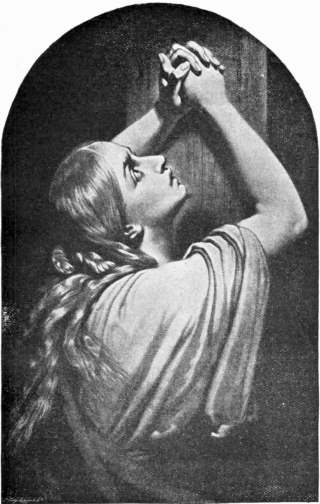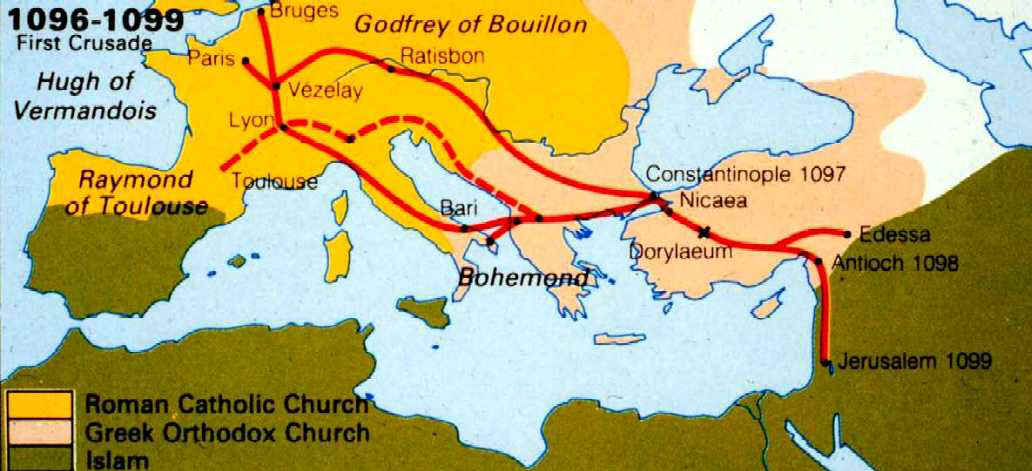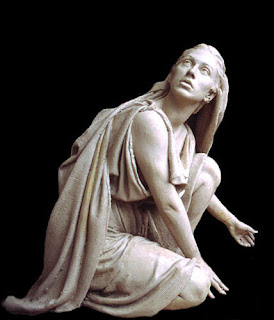Mary Magdalene is a woman who was mentioned several times in the Christian Gospels of Matthew, Mark, Luke, and John. She is most famous for being one of the women who was present at the crucifixion of Jesus, and for being the first person to see him resurrected. But the story doesn't stop there. She was later a very important figure in what we've come to call Gnostic Christianity, a group of early Christian sects that didn't survive past the 6th century C.E.
Very early on, Mary Magdalene was confused with two other women in the Gospels, which may have led to her reputation as a redeemed harlot. Today we've come to recognize that there is no textual support for such a claim, but still the image of Mary Magdalene as a penitent sinner persists. Throughout the Middle Ages this was to have an impact on her legend, which grew in complexity and depth as Christian theology and Western civilization continued to evolve.
Early in the 20th century it was suggested that Jesus was married to Mary Magdalene but the idea had little lasting impact. The notion was reintroduced in the 1980s in a book called Holy Blood, Holy Grail, and this time it caused a national sensation. A whole new genre of non-fiction was born, centered around the idea of Mary Magdalene as the wife of Jesus. Also in the late 20th century a great deal of scholarship emerged exploring the Gnostic writings about Mary Magdalene and her role as an apostle. Both of these perspectives on Mary Magdalene converged in 2003 and 2004 in the wake of the publication of Dan Brown's novel, The Da Vinci Code, a best-seller that explores some of the recent theories about Mary Magdalene as Jesus' lost bride.
And The St. Mary Magdalen (Feast day - July 22).

PRAYER (traditional language)
Almighty God, whose blessed Son restored Mary Magdalene To health of body and mind, and called her to be a witness of his resurrection: Mercifully grant that by thy grace we may be healed of all our infirmities and know thee in the power of his endless life; who with thee and the Holy Spirit liveth and reigneth, one God, now and for ever.
THE PENGUIN DICTIONARY OF SAINTS, by Donald Attwater (Penguin Books, London, 2nd ed, 1983) under "Mary Magdalene" Among other women [besides Mary Magdalene] mentioned in the gospels are the unnamed woman "who was a sinner" (Luke 7:37-50), and Mary of Bethany, Martha's sister (Luke 10:38-42). These are not further identified, and in Eastern tradition they are usually treated as three different persons. But the West, following St. Gregory the Great [540?-604], regarded them as one and the same, though weighty voices from St Ambrose [337?-397] onwards preferred to leave the question undecided. This western tradition resulted in St. Mary Magdalene's being looked on as an outstanding type of the penitent and the contemplative. The eastern tradition has now been adopted in the new Roman calendar(1969).
However the Second Vatican Council removed the prostitute label in 1969.
What the story is about:
Mary Magdalene led a group of women who were prominent followers of Jesus of Nazareth. They were the main witnesses of all the key events in Jesus' life:
The idea of women as primary witnesses does not seem very startling to people in the 20th century, but it was a revolutionary concept at the time. The testimony of women was not given the same weight as men's, either personally or in a court of law.
When the Christian stories described Mary Magdalene and the other women as the first witnesses of the Resurrection, they were saying something important about the status of women within Christianity.
The story of Mary Magdalene contains four different episodes:
1 Mary Magdalene as a disciple of Jesus (Luke 8:1-3)
Mary is described as a woman whom Jesus cured of an unspecified illness. She led a group of women who provided for Jesus and his followers from their own financial resources.
2 Mary at the crucifixion (Mark 15:40-41, Luke 23:49, Matthew 27:55-56, John 19:25)
In each of the four accounts of the crucifixion Mary was present, either standing at a distance with other women, or standing near the cross.
3 Mary prepared Jesus’ body for burial (Luke 23:55-56, Matthew 27:61)
Mary watched as Jesus’ body was sealed inside the tomb of Joseph of Arimathea. She could confirm that he was really dead. She and the other women prepared the spices needed for proper burial of a body.
4 Mary witnesses the resurrection (Mark 16:1-11, Luke 24:1-11, Matthew 28:1-10, John 20:1-18).
Mary found that Jesus’ body was no longer in the tomb. She received a message from an angel and was the first person to see the risen Jesus. She was thus the first witness of the resurrection.
Mary Magdalene, disciple of Jesus:
As Jesus moved throughout the country, teaching and talking about God, he was accompanied by a group of women. Mary Magdalene was the main woman in this group.
‘Soon afterwards he went on through cities and villages, proclaiming and bring the good news of the kingdom of God.
The twelve were with him, as well as some women who had been cured of evil spirits and infirmities: Mary called Magdalene, from whom seven demons had gone out, and Joanna the wife of Herod’s steward Chuza, and Susanna, and many others, who provided for them out of their resources.’
(Read Luke 8:1-3)
Mary’s town of Magdala was a thriving center of the fishing industry, producing smoked fish in large quantities. It was also known as a manufacturing center for fine wool and woolen dyes. Mary probably lived in a comfortable village house similar to the ones shown at Bible Architecture: Houses
Mary at the Crucifixion:
All four accounts of the crucifixion and death of Jesus say that women were at the scene, and Mary Magdalene was prominent among these women. She had been close to Jesus during his life. She stayed close to him as he faced death.
‘There were also women looking on from a distance. Among them were Mary Magdalene and Mary the mother of James the younger and of Joses, and Salome. These used to follow him and provided for him when he was in Galilee. And there were many other women who had come up with him to Jerusalem.’
(Read Mark 15:40-41)
See Bible Archaeology: Crucifixion for information on the horrific process of crucifixion, and on archaeological evidence for this form of execution.
There are three groups of women mentioned in these verses from Mark:
-
the inner core of women who were close friends or relatives of Jesus
-
the women who provided for him from their financial resources
-
the women who came up with Jesus to Jerusalem, just prior to his execution.
Matthew 26:56 makes the point that all the male disciples deserted Jesus and fled for their lives. But the women remained, standing as near as they dared to the spot where the soldiers were carrying out the brutal execution.
This does not mean that the men were more cowardly than the women. It was simply more dangerous for them to be near the execution site. The Romans saw Jesus as a dangerous rebel leader, and so they viewed Jesus’ male friends with suspicion. The male disciples might easily have been arrested as co-conspirators, so they kept their distance. Women were seen as less threatening and so their presence was tolerated.
The Burial Preparations of Jesus' body:
 In this part of the story, Mary
In this part of the story, Mary -
was present at the temporary burial of Jesus and saw him placed in the tomb, then
-
returned to the place were they were staying and collected the materials needed for a proper burial.
‘The women who had come with him from Galilee followed, and they saw the tomb and how his body was laid. Then they returned, and prepared spices and ointments.’
(Read Luke 23:55-56, Mark 15:47, Matthew 27:61)
The burial seems to have been done hastily, either because it was night or because of the approaching Sabbath. Pilgrims who died in Jerusalem and people who were executed were temporarily buried in graves for non-residents, and then later removed to the tomb of their family.
See Bible Archaeology: Tombs for images of the interior and exterior of tombs from the time of Jesus.
The presence of the women at the tomb was meant to highlight the factual nature of the burial: that Jesus was indeed dead, and that his body had been buried in the normal manner.
This point was later disputed by people who said that Jesus had not been dead, but merely unconscious. Since women’s testimony was not given the same weight as men’s in courts of law, this might have been a problem. Deuteronomy 19:15 stipulated that at least two or three witnesses were needed to prove that something had happened.
But the gospels stress that as well as the women, Joseph of Arimathea, a respected member of the Council, was there, so the required number of witnesses was present at the tomb of Jesus to verify that he was really dead.
Mary witnesses the Resurrection:
According to Jewish law, ointments and spices could not be bought or sold on the Sabbath.Jesus’ death had been sudden, unexpected. The women did not have the necessary burial spices. So they waited until the Sabbath was over, bought the spices, and went to the tomb.
The women intended to wash and anoint the body of Jesus. This was a traditional task of Jewish women, as they prepared the bodies of family members for burial. It was a last, gentle service given to the body of the person they loved.
But when they got to the tomb, they found it empty of Jesus’ body. At this moment Mary had a profound revelation where she 'saw' and 'heard' Jesus. She understood in a way that is not easily explained that Jesus was no longer dead, but alive. She experienced what the gospels call an ‘angel’, a message from God that gave her an unshakeable conviction that Jesus lived.
‘But Mary stood weeping outside the tomb. As she wept, she bent over to look into the tomb, and she saw two angels in white, sitting where the body of Jesus had been lying, one at the head and the other at the feet.
They said to her “Woman, why are you weeping?”
She said to them “They have taken away my Lord, and I do not know where they have laid him”.
When she had said this, she turned around and saw Jesus standing there, but she did not know that it was Jesus.
Jesus said to her “Woman, why are you weeping? Whom are you looking for?”
Supposing him to be the gardener, she said to him “Sir, if you have carried him away, tell me where you have laid him, and I will take him away”.
Jesus said to her “Mary!”
She turned and said to him in Hebrew “Rabbouni!” (which means Teacher).
Jesus said to her “Do not hold on to me, because I have not yet ascended to the Father. But go to my brothers and say to them “I am ascending to my Father and your Father, to my God and your God.”
Mary Magdalene went and announced to the disciples “I have seen the Lord”. And she told them that he had said these things to her.’
(Read John 20:11-18, Mark 16:1-11, Luke 24:1-11, Matthew 28:1-10)
Mary saw and heard Jesus. She was the first witness of the Resurrection.
She was convinced that he was alive, although she was too distraught to recognize him immediately.
It is interesting that in this moment of extreme emotion she calls him 'rabbouni', the title his disciples would have used.
She did not call him by his own personal name of 'Jesus', which she surely would have done if she and Jesus had had the sort of intimate relationship that has been suggested in popular novels. She used the word she had always used as his name, 'rabbouni', teacher.
Jesus told Mary not to cling to him, but to let him go. He was telling her that their former way of life has ended, that she must let go and move on. They are words that are often said by those who seek to comfort and advise people who are grieving.
In a way the angel said the same thing: “Why do you seek the living among the dead?” Death had happened, nothing would ever be the same. Your place is now with the living.
At the tomb, Mary was given instructions. She was told by Jesus or by the angel to “Go to my brothers and say to them….” Mary then ‘went and announced’. With these words Mary was commissioned as an apostle of Jesus (‘go and tell’ is apostellein in Greek). She was an apostle in the same way as the men (the Twelve and the other disciples) who were commissioned to spread the story of Jesus.
Until the third century, teachers in the Christian church referred to Mary as an ‘apostle’, and she is still called ‘apostle to the apostles’ by the Eastern Catholic churches. She has been one of the most revered figures in Christian history.
In his letter to the Corinthians, Paul does not include the women at the tomb among the witnesses to the Resurrection. According to his narrative, Jesus appeared to Cephas, and then to the twelve male disciples, then to 500 people, then to James, then to all the apostles. Mary of Magdala is not mentioned. Paul was writing to Greeks in Corinth, and sadly his letter reflects the culture of the Greeks, who viewed the testimony of women as unreliable.
Summary:
Mary was present at all the major events in Jesus' life.
She was there during his ministry, heard him teach, and may have been the major financial backer sustaining him and the group of disciples who followed him - pious writers have overlooked the practicalities of sustaining a group of men for several years, but Mary did not.
She was there during the crucifixion and death of Jesus - all four gospels mention her presence, faithful to the end.
Most importantly, she was there at the resurrection, the first witness of this world-changing event, and commissioned by the angel to 'go and tell', as an apostle to the apostles.
SOME EXTRA SNIPPETS:
'There is a good deal of evidence that in the Greco-Roman world in general women were thought be educated men to be gullible in religious matters and especilly prone to superstititus fantasy and excessive in religious practices. Strabo, for example, points out that "in dealing with a crowd of women.... a philosopher cannot influence them by reason or exhort them to reverence, piety and faith; nay, there is need to religious fear also, and this cannot be arounsed without myths and marvels" (Geog.1.2.8).
We are fortunate to have an example of this prejudice directed specifically against Mary Magdalene as an alleged witness to the resurrection by the second-century pagan intellectual despiser of Christianity, Celsus: "after death he rose again and showed the marks of his punishment and how his hands, had been pierced. But who saw this? A hysterical female, as you say, and perhaps some other one of those who were deluded by the same sorcery" (apud Origen.C.Cels.2.55). Even allowing for Celsus's polemical intent in focusing on a female witness of the resurrection, it is notable that the appearance to Mary Magdalene was sufficiently prominent what Celsus knew of the Christian claim about the resurrection of Jesus for him to be able to take it up in this way. There can hardly be any doubt that the gender of the "hysterical" or "crazed" woman is important to Celsus's sneering polemic.'
(Quoted from 'Gospel Women: Studies of the Named Women in the Gospels', Richard Bauckham, p270-271).


















